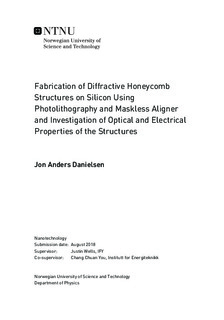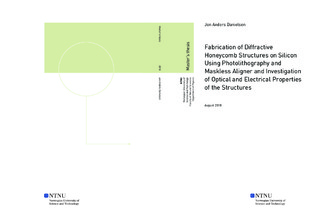| dc.description.abstract | Surface texturing is an important method for increasing absorption of light in solar cells. This is done by creating surface structures that increase the optical path-length of photons within the cell, through light-trapping properties. Diffractive honeycomb structures fabricated by laser processing are an example of such texturing methods that have been investigated for use in thin silicon solar cells. A diffractive honeycomb structure is a hexagonal pattern of holes where the feature sizes are roughly the same lengths as the wavelength of visible light.
In this thesis, diffractive honeycomb structures are fabricated by photolithography, using the Maskless Aligner 150 and inductively coupled plasma reactive ion etching (ICP-RIE). Three parameters of the structures are also further investigated; the depth of the holes, the width of the holes, and the coverage ratio of structure to surface area, through the distance between the holes. Light reflection measurements are used to measure the impact of the different parameters on the light harvesting properties of the texture. Additionally, the impact of the surface structures on the electrical properties of the silicon wafer is measured, using photoluminescence (PL) and the quasi-steady state photoconductance (QSSPC) method.
The fabrication of the diffractive honeycomb structures using the Maskless Aligner 150 is considered partially successful. While several samples were fabricated successfully, the method was somewhat unreliable, and the issues that resulted in unsuccessful samples were not clearly identified. The reflection measurements were also affected by the issues in the fabrication method, as some of the samples measured turned out to be unsuccessful samples. For the hole depth measurements, no clear trend could be extracted, but they somewhat indicated that deeper holes have lower reflection. For the hole width measurements, the results indicated a decrease in reflection for hole width lower than 2.5 \textmu m, but no optimal parameter was identified. For the coverage measurements, an overall trend could be seen towards higher coverage ratio resulting in lower reflection values. Lastly, the results from the PL measurements indicated that the diffractive honeycomb structures do affect the electrical properties of the wafer negatively, by lowering the effective lifetime of the minority charge carriers. | |

